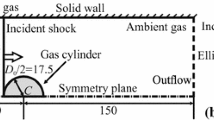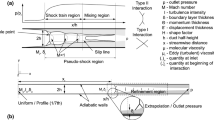Abstract
The separation and shock wave formation on the aft-body of a hypersonic adiabatic circular cylinder were studied numerically using the open source software OpenFOAM. The simulations of laminar flow were performed over a range of Reynolds numbers (\(8\times 10^3 < Re < 8\times 10^4\)) at a free-stream Mach number of 5.9. Off-body viscous forces were isolated by controlling the wall boundary condition. It was observed that the off-body viscous forces play a dominant role compared to the boundary layer in displacement of the interaction onset in response to a change in Reynolds number. A modified free-interaction equation and correlation parameter has been presented which accounts for wall curvature effects on the interaction. The free-interaction equation was manipulated to isolate the contribution of the viscous–inviscid interaction to the overall pressure rise and shock formation. Using these equations coupled with high-quality simulation data, the underlying mechanisms resulting in Reynolds number dependence of the lip-shock formation were investigated. A constant value for the interaction parameter representing the part of the pressure rise due to viscous–inviscid interaction has been observed at separation over a wide range of Reynolds numbers. The effect of curvature has been shown to be the primary contributor to the Reynolds number dependence of the free-interaction mechanism at separation. The observations in this work have been discussed here to create a thorough analysis of the Reynolds number-dependent nature of the lip-shock.












Similar content being viewed by others
References
Aghababaie, A.A., Theunissen, R.: Modeling free shock separation induced side loads in overexpanded rocket nozzles. AIAA J. 53(1), 93–103 (2015). doi:10.2514/1.J053014
Anderson, J.D.: Hypersonic and High-Temperature Gas Dynamics, 2nd edn. American Institute of Aeronautics and Astronautics, Blacksburg (2006)
Arisman, C., Johansen, C.T.: Nitric oxide chemistry effects in hypersonic boundary layers. AIAA J. 53(12), 3652–3660 (2015)
Arisman, C., Johansen, C.T., Bathel, B., Danehy, P.: Investigation of gas seeding for planar laser-induced fluorescence in hypersonic boundary layers. AIAA J. 53(12), 3637–3651 (2015)
Arisman, C., Johansen, C.T., Galuppo, W., McPhail, A.: Nitric oxide chemistry effects in hypersonic boundary layers. In: 43rd Fluid Dynamics Conference. American Institute of Aeronautics and Astronautics, Reston, Virginia (2013). doi:10.2514/6.2013-3104
Bashkin, V.A., Vaganov, A.V., Egorov, I.V., Ivanov, D.V., Ignatova, G.A.: Comparison of calculated and experimental data on supersonic flow past a circular cylinder. Fluid Dyn. 37(3), 473–483 (2002)
Baum, E.: Interacting supersonic laminar wake calculations by a finite difference method. AIAA J. 5(7), 1224–1230 (1967). doi:10.2514/3.4175
Baum, E.: An interaction model of a supersonic laminar boundary layer on sharpand rounded backward facing steps. AIAA J. 6(3), 440–447 (1968). doi:10.2514/3.4518
Baum, E., King, H.H., Denison, M.R.: Recent studies of the laminar base-flow region. AIAA J. 2(9), 1527–1534 (1964)
Bekka, N., Sellam, M., Chpoun, A.: Aeroelastic stability analysis of flexible overexpanded rocket nozzle. Shock Waves (2015). doi:10.1007/s00193-015-0575-2
Carrière, P., Sirieix, M., Solignac, J.L.: Similarity properties of the laminar or turbulent separation phenomena in a non-uniform supersonic flow. In: Hetenyi, M., Vincenti, W.G. (eds.) Applied Mechanics. Proceedings of the Twelfth International Congress of Applied Mechanics, Stanford University, August 26–31, 1968 pp. 145–157. Springer, Berlin, Heidelberg (1968)
Chapman, D.R.: Laminar mixing of a compressible fluid (Report 958). Technical report, National Advisory Committee for Aeronautics (1950). http://ntrs.nasa.gov/archive/nasa/casi.ntrs.nasa.gov/19930092022.pdf
Chapman, D.R., Kuehn, D.M., Larson, H.K.: Investigation of separated flows in supersonic and subsonic streams with emphasis on the effect of transition (Report 1356). Technical report, National Advisory Committee for Aeronautics (1958)
Combs, C.S., Clemens, N.T., Danehy, P.M., Bathel, B., Parker, R., Wadhams, T., Holden, M., Kirk, B.: NO PLIF visualization of the orion capsule in LENS-I. In: 51st AIAA Aerospace Sciences Meeting. American Institute of Aeronautics and Astronautics, Grapevine, Texas (2013)
Crocco, L., Lees, L.: A mixing theory for the interaction between dissipative flows and nearly isentropic streams. J. Aeronaut. Sci. 19(10), 649–676 (1952)
Delery, J.: Physical introduction, chap. 2. In: Babinsky, H., Harvey, J.K. (eds.) Shock Wave-Boundary Layer Interactions, 1st edn, pp. 5–86. Cambridge University Press, New York (2011)
Denison, M.R., Baum, E.: Compressible free shear layer with finite initial thickness. AIAA J. 1(2), 342–349 (1963). doi:10.2514/3.1535
Dewey, C.F.: Near wake of a blunt body at hypersonic speeds. AIAA J. 3(6), 1001–1010 (1965)
Dyakonov, A.A., Schoenenberger, M., Scallion, W.I., Norman, J.W.V., Novak, L.A., Tang, C.Y.: Aerodynamic interference due to MSL reaction control system. In: 41st AIAA Thermophysics Conference, pp. 1–16 (2009)
Erdos, J., Pallone, A.: Shock boundry layer interaction and flow separation. In: Proceedings of the 1962 Heat Transfer and Fluid Mechanics Institute, Stanford University Press (1962)
Grange, Jm, Klineberg, J.M., Lees, L.: Laminar boundary-layer separation and near-wake flow for a smooth blunt body at supersonic and hypersonic speeds. AIAA J. 5(6), 1089–1096 (1967)
Grasso, F., Pettinelli, C.: Analysis of laminar near-wake hypersonic flows. J. Spacecr. Rockets 32(6), 970–980 (1995). doi:10.2514/3.26717
Greenshields, C.J., Weller, H.G., Gasparini, L., Reese, J.M.: Implementation of semi-discrete, non-staggered central schemes in a colocated, polyhedral, finite volume framework, for high-speed viscous flows. Int. J. Numer. Methods Fluids (2009). doi:10.1002/fld.2069
Hama, F.R.: Experimental studies on the lip shock. AIAA J. 6(2), 212–219 (1968)
Hollis, B.R.: Blunt-body entry vehicle aerotherodynamics: transition and turbulent heating. J. Spacecr. Rockets 49(3), 435–449 (2012). doi:10.2514/1.51864
Hruschka, R., O’Byrne, S., Kleine, H.: Comparison of velocity and temperature measurements with simulations in a hypersonic wake flow. Exp. Fluids 51(2), 407–421 (2011). doi:10.1007/s00348-011-1039-9
Johansen, C.T., Danehy, P.M., Ashcraft, S.W., Bathel, B.F., Inman, Ja, Jones, S.B.: Planar laser-induced fluorescence of Mars Science Laboratory reaction control system jets. J. Spacecr. Rockets 50(4), 781–792 (2013). doi:10.2514/1.A32214
Johansen, C.T., Novak, L., Bathel, B.F., Ashcraft, S.W., Danehy, P.M.: Mars Science Laboratory reaction control system jet computations with visualization and velocimetry. J. Spacecr. Rockets 50(6), 1183–1195 (2013). doi:10.2514/1.A32496
Keanini, R.G., Brown, A.M.: Scale analysis and experimental observations of shock-induced turbulent boundary layer separation in nozzles. Eur. J. Mech. B/Fluids 26(4), 494–510 (2007). doi:10.1016/j.euromechflu.2006.10.002
Lees, L.: Hypersonic wakes and trails. AIAA J. 2(3), 417–428 (1964)
Lees, L., Reeves, B.L.: Supersonic separated and reattaching laminar flows: I. General theory and application to adiabatic boundary-layer/shock-wave interactions. AIAA J. 2(11), 1907–1920 (1964)
McCarthy, J.F., Kubota, T.: A study of wakes behind a circular cylinder at m equal 5.7. AIAA J. 2(4), 629–636 (1964). doi:10.2514/3.2399
Nance, R.P., Hollis, B.R., Horvath, T.J., Alter, S.J., Hassan, H.A.: Computational study of hypersonic transitional wake flow. J. Thermophys. Heat Transf. 13(2), 236–242 (1999). doi:10.2514/2.6441
NIST-JANAF: NIST-JANAF Thermochemical Tables (2013). http://kinetics.nist.gov/janaf/
O’Byrne, S.: Hypersonic laminar boundary layers and near-wake flows. Ph.D. thesis, The Australian National University (2001)
Ohrenberger, J.T., Baum, E.: A theoretical model of the near wake of a slender body in supersonic flow. AIAA J. 10(9), 1165–1172 (1972). doi:10.2514/3.50344
Ostlund, J., Muhammad-Klingmann, B.: Supersonic flow separation with application to rocket engine nozzles. Appl. Mech. Rev. 58(3), 143 (2005). doi:10.1115/1.1894402
Park, G., Gai, S.L., Neely, A.J.: Laminar near wake of a circular cylinder at hypersonic speeds. AIAA J. 48(1), 236–248 (2010). doi:10.2514/1.44167
Rathakrishnan, E.: Theoretical Aerodynamics, 1st edn. John Wiley & Sons Singapore Pte. Ltd., Singapore (2013)
Reeves, B.L., Lees, L.: Theory of laminar near wake of blunt bodies in hypersonic flow. AIAA J. 3(11), 2061–2074 (1965)
Skurin, I., Yurkov, A.V.: Approximate calculation of parameters at the throat of a hypersonic wake. J. Appl. Mech. Tech. Phys. 19(2), 183–187 (1978)
Smith, J.H., Lamb, J.P.: Eclectic merger of crocco-lees and chapman-korst approach to near-wake. Int. J. Heat Mass Transf. 17, 1571–1589 (1974)
Tewfik, O.K., Giedt, W.H.: Heat transfer, recovery factor and pressure distributions around a circular cylinder normal to a supersonic rarefied-air stream. J. Aerosp. Sci. 27(10), 721–729 (1960)
Weinbaum, S.: Rapid expansion of a supersonic boundary layer and its application to the near wake. AIAA J. 4(2), 217–226 (1966). doi:10.2514/3.3422
Weiss, R.F.: Base pressure of slender bodies in laminar, hypersonic flow. AIAA J. 4(9), 1557–1559 (1966). doi:10.2514/3.3735
Weiss, R.F.: A new theoretical solution of the laminar, hypersonic near wake. AIAA J. 5(12), 2142–2149 (1967). doi:10.2514/3.4399
Weiss, R.F., Weinbaum, S.: Hypersonic boundary-layer separation and the base flow problem. AIAA J. 4(8), 1321–1330 (1966). doi:10.2514/3.3672
Acknowledgments
This research was enabled in part by support provided by WestGrid (http://www.westgrid.ca) and Compute Canada Calcul Canada (http://www.computecanada.ca). Financial support was provided by Dr. Johansen’s Discovery Grant under the Natural Sciences and Engineering Research Council of Canada (NSERC). Mr. Hinman was partially supported through the Queen Elizabeth II Graduate Scholarship (QEII) administered by the government of Alberta.
Author information
Authors and Affiliations
Corresponding author
Additional information
Communicated by H. Olivier.
Appendix: Derivation of free-interaction for a cylindrical aft-body
Appendix: Derivation of free-interaction for a cylindrical aft-body
The following derivation follows closely the derivation given by Délery [16] for the Chapman [13] free-interaction theory. Starting with the boundary layer momentum equation in the streamwise direction at the wall the following simple relationship can be found. In these derivations, x refers to the streamwise distance, and y refers to the wall normal distance.
Integrating both sides:
Introducing the non-dimensional variables \(\bar{\tau }=\tau /\tau _\mathrm{wo}\), \(\bar{y}=y/\delta _\mathrm{o}^*\), \(q_\mathrm{o}=0.5\gamma p_\mathrm{e}\left( x_\mathrm{o}\right) M_\mathrm{e,o}^2\) and \(C_{fo}=\tau _\mathrm{wo}/q_\mathrm{o}\) the equation becomes:
where:
This is the first equation needed to define the interaction. The second equation represents the pressure rise due to external flow deflection.
In its linearized form:
The following is the only significant difference from the derivation of Chapman [13, 16]. The streamline deflection angle \(\varphi \) in the case of a cylinder is the sum of the deflection from viscous–inviscid interaction and the deflection of the cylindrical aft-body. As well, because we know that there is vertical pressure gradient and rotational flow, the deflection is actually an effective angle that would result in the given pressure rise. In the general case of flat-plate flow it is a good assumption that the compression is only due the displacement thickness growth \({\hbox {d}} \delta ^* / {\hbox {d}}x\). Here we do not specify that this is the specific viscous–inviscid mechanism. Therefore:
where \(\Delta \varphi _{ eff } \) is the effective angle change due to viscous–inviscid interaction. \(\Delta \alpha \) is the angle change due to the surface deflection of the cylinder. If we assume that \(\Delta \varphi _{ eff } \) scales with \(\delta _\mathrm{o}^*/L_{ sep }\), and \(\Delta \alpha \) scales with the angular length of the interaction \(\theta _{ sep }=L_{ sep }/r\) and introducing the same dimensionless variables as the previous step, we can get the following function:
The function \(f_2\left( \bar{x}\right) \) is the dimensionless effective angle change due to viscous–inviscid interaction. In the flat-plate case this can be assumed to be equal to \({\hbox {d}}\bar{\delta _\mathrm{o}^*}/{\hbox {d}}\bar{x}\). The function \(f_3\left( \bar{x}\right) \) is the dimensionless angle change due to the cylinder angle. Multiplying (18) and (23) and taking the square root we get the following:
or
The above equation is in the same form as the free-interaction theory equation from Chapman [13]. However, the interaction parameter is denoted \(F^*\left( \bar{x}\right) \) because it incorporates both the effect of the geometry and the free-interaction. This equation would also be appropriate for a geometry other than a cylinder provided the radius of curvature is relatively constant throughout the interaction region. Equation 24 can be rearranged for the free-interaction parameter \(F\left( \bar{x}\right) =\sqrt{f_1\left( \bar{x}\right) f_2\left( \bar{x}\right) }\) to give:
Rights and permissions
About this article
Cite this article
Hinman, W.S., Johansen, C.T. Interaction theory of hypersonic laminar near-wake flow behind an adiabatic circular cylinder. Shock Waves 26, 717–727 (2016). https://doi.org/10.1007/s00193-015-0615-y
Received:
Revised:
Accepted:
Published:
Issue Date:
DOI: https://doi.org/10.1007/s00193-015-0615-y




